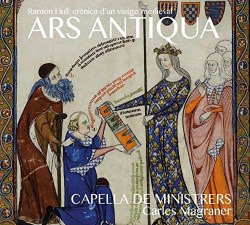Program: #16-24 Air Date: Jun 06, 2016
To listen to this show, you must first LOG IN. If you have already logged in, but you are still seeing this message, please SUBSCRIBE or UPGRADE your subscriber level today.
The Capella de Ministrers are back with an exploration into the life and times of the mystic Ramon Llul; and Dialogos traces the oral roots of Dalmatian chant.
I. Ramon Llull: Ars Antiqua. Capella de Ministrers CD 1637.

CAPELLA DE MINISTRERS
MUSICA RESERVATA BARCELONA
CARLES MAGRANER, dirección
Carles Magraner, viella, violas
Aziz Samsaoui, sas çura, ud, qanun
Jota Martínez, viola de rueda, organistrum,
laúd otomano, laúd medieval, cítola, setar,
guiterna, baglama, añafil, pedal organetto
José Luis Pastor, laúd, medieval, cítola
Eduard Navarro, duduk, oud, cornamusas,
chirimía, chalumeau
Miguel Ángel Orero, salterio, percusiones
Pau Ballester, tintinnabulum, percusiones
Spyros Kaniaris, Lyra de Pontos, bouzouki
David Antich, flautas
Manuel Vilas, arpa
Ignasi Jordá, exaquier, organetto
Musica Reservata BarcelonaCarles Magraner proposes a musical journey around the Medieval Mediterranean to the hand of one of the most important theologists and philosophers of the History: Raymundus Lullus. The musical references of his writings are brief but fundamental. In the "Revelatio Secretorum Artis" the 18th century german lullist Ivo Salzinger wrote his work "De Secreto Musicae" where, after reiterate the musical authority of Boethius and Pythagoras, deals with the division of the monochord, the musical consonances and the solmisation system of Guido d’Arezzo, and following Lullus says that music is "ars inventa ad ordinandum multas voces concordantes in uno canto".
However, in the “Tree of Knowledge’’, where Lullus imagines fourteen trees of knowledge, the most important is the “humanal tree’’, in which the music takes place, and we must “consider the voices to be high and low and medium, and long and short, thin and depth, proportional to the vocal and consonant accents, to adorn the voices and the melody of the instruments, that are pleasing to be heard by the hearts of the men’’. Other musical references in Lullus are found also in his “Doctrina Pueril’’, where he wrote: “The music is the art by which we have the straight doctrine to sing and play the instruments, raising and lowering the voices in a form to concur the different voices and sounds’’.
2. Ben volgra, s’esser poges (Guiraut d’Espanha)
3. Je muir d’amourete (Adam de la Halle)
4. Plany de la Verge (Anònim català/occità)
5. Alta Trinità beata (Laudario di Cortona 32)
6. Quant je parti de m’amie (Codex Montpellier 200)
7. Los set gotxs recomptarem (Llibre Vermell 5)
8. Non sofre Santa Maria (Cantiga de Rocamadour)
9. Dregz de natura comanda (Matfré Ermengau)
10. Mundi renovatio (Adam de Saint-Victor)
11. Dansse real
12. Mayre de Deu e fylha (Cantiga 159)
13. Amis, amis (Trouvère anònima)
14. On doit plaindre (Adam de la Halle)
15. Fi, maris (Adam de la Halle)
II. Dalmatica: Chants of the Adriatic (Dialogos/Kantaduri/Katarina Livljanić). Arcana CD A395.

The Dialogos vocalists perform some rare gems conserved in Latin manuscripts, some of them coming from the female monastic world, while the Glagolitic chants originating from the coastal, insular and hinterland regions of Croatia are sung by the the vocal ensemble Kantaduri, creating together a rich sound fresco.
|
Ispovidajte se Gospodinu, jer je dobar
|
3:20
|
|
|
2
|
Sanctus. Osanna dulcis est cantica
|
2:36
|
|
3
|
O, prislavna Božja Mati
|
2:20
|
|
4
|
Jube, Domine, nos tibi laudes canere / Consolamini, consolamini
|
7:16
|
|
5
|
Spavaj, spavaj, ditiću, ti nebeski Kraljiću
|
1:48
|
|
6
|
O, Bog se rodo, Vitlijanjo
|
2:43
|
|
7
|
In principio erat Verbum
|
6:49
|
|
8
|
Velika nam djela učini Gospodin
|
1:46
|
|
9
|
Pistula
|
2:56
|
|
10
|
U se vrime godišta
|
2:10
|
|
11
|
Annuntiamus vobis universali gaudio / Navišćujemo vam općeno veselje
|
6:47
|
|
12
|
Tri su kralja idrila, da b’ Isusa vidila / Kad se Isus, Ditić, u Betlem porodi
|
2:54
|
|
13
|
Tota pulchra es, Maria
|
2:35
|
|
14
|
Slava, čast i hvala ti
|
1:40
|
|
15
|
Ante diem sanctum Paschae
|
3:49
|
|
16
|
Potamnjele oči moje od plača moga
|
1:55
|
|
17
|
Crucem tuam adoramus / Križu sveti, Križu blagi
|
4:29
|
|
18
|
Ego sum alpha et omega
|
2:54
|
|
19
|
Ja se kajem Bože mili
|
2:35
|
|
20
|
Govorenje Judino skalam na obišenje hodeći / Štrofa / Kantanje
|
7:19
|
|
21
|
Svit se konča
|
5:31
|
|
22
|
Puče moj
|
3:13
|
|
23
|
Pismu novu svi pivajmo
|
3:23
|
|
24
|
Ante sex dies Pasche
|
6:23
|
CD Info
CD 1637, CD A395